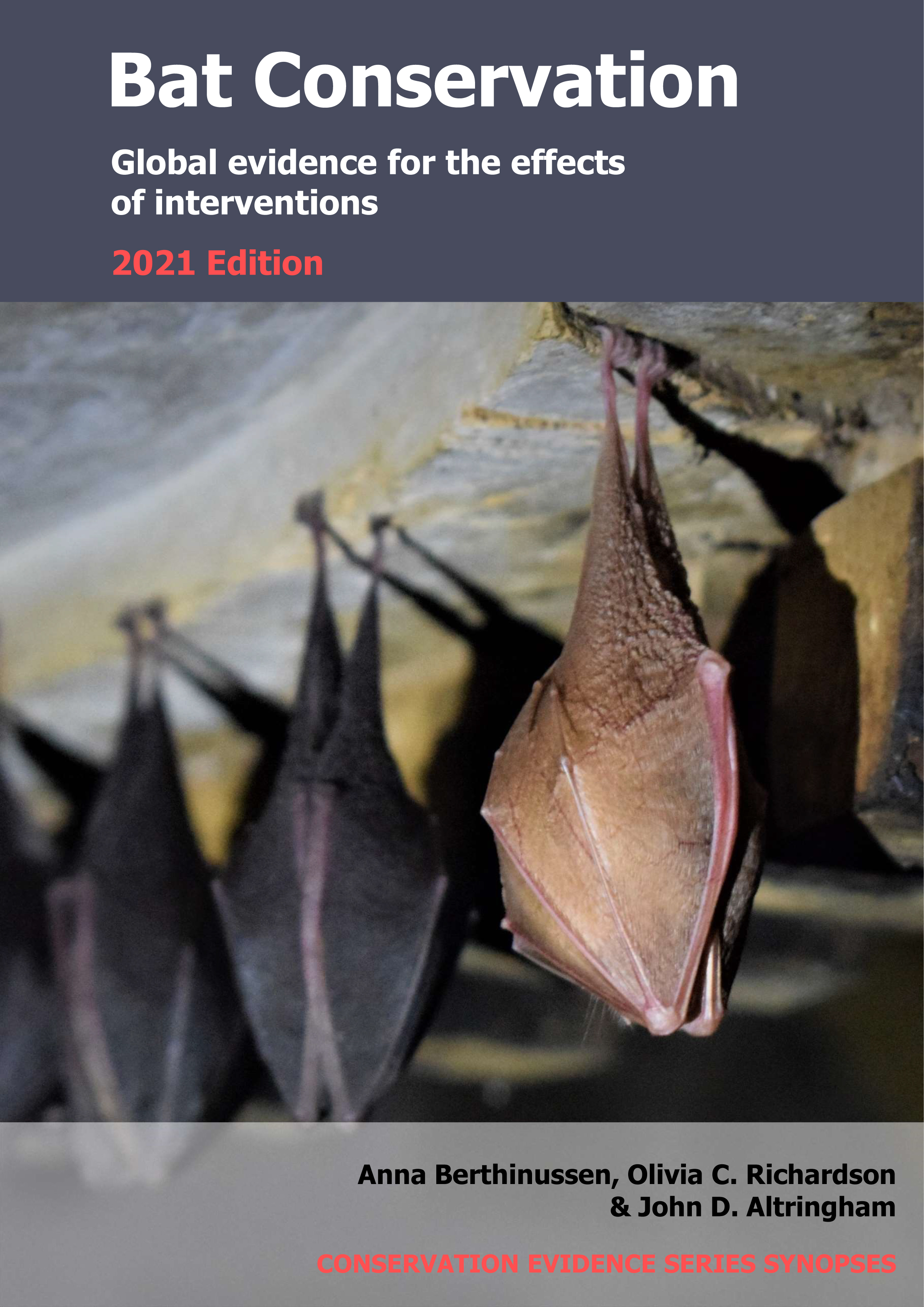Actions to conserve biodiversity
We have summarised evidence from the scientific literature about the effects of actions to conserve wildlife and ecosystems.
Review the evidence from the studies
Not sure what Actions are? Read a brief description.
Search for evidence
e.g. "frogs chytrid"
200 Actions found
Refine
Hide
200 Actions found
Download Actions
| 0 selected |
|
Order results by:
| Action | Effectiveness | Studies | Category | |
|---|---|---|---|---|
|
Adapt bat roost structures to buffer against temperature extremes Action Link |
No evidence found (no assessment) | 0 |
|
|
|
Apply textured coating to turbines Action Link |
Unknown effectiveness (limited evidence) | 1 |
|
|
|
Automatically reduce turbine blade rotation when bat activity is high Action Link |
Likely to be beneficial | 2 |
|
|
|
Avoid illumination of bat commuting routes Action Link |
Likely to be beneficial | 3 |
|
|
|
Avoid illumination of bat foraging, drinking and swarming sites Action Link |
Likely to be beneficial | 2 |
|
|
|
Avoid planting fruit trees alongside roads/railways in areas with fruit bats Action Link |
No evidence found (no assessment) | 0 |
|
|
|
Avoid the use of antiparasitic drugs for livestock Action Link |
No evidence found (no assessment) | 0 |
|
|
|
Breed bats in captivity Action Link |
Unknown effectiveness (limited evidence) | 8 |
|
|
|
Breed bats in captivity to supplement wild populations affected by white-nose syndrome Action Link |
No evidence found (no assessment) | 0 |
|
|
|
Carry out surveillance of bats to prevent the spread of disease/viruses to humans to reduce human-wildlife conflict Action Link |
No evidence found (no assessment) | 0 |
|
|
|
Change effluent treatments of domestic and urban waste water Action Link |
Unknown effectiveness (limited evidence) | 1 |
|
|
|
Change effluent treatments used in agriculture and forestry Action Link |
No evidence found (no assessment) | 0 |
|
|
|
Change timing of building work Action Link |
Unknown effectiveness (limited evidence) | 1 |
|
|
|
Change timing of forestry operations Action Link |
No evidence found (no assessment) | 0 |
|
|
|
Change timing of maintenance work at road/railway bridges and culverts Action Link |
No evidence found (no assessment) | 0 |
|
|
|
Close off potential access points on turbines to prevent roosting bats Action Link |
No evidence found (no assessment) | 0 |
|
|
|
Conserve roosting sites for bats in old structures or buildings Action Link |
Likely to be beneficial | 3 |
|
|
|
Control harmful invasive bat prey species Action Link |
No evidence found (no assessment) | 0 |
|
|
|
Control invasive non-predatory competitors Action Link |
No evidence found (no assessment) | 0 |
|
|
|
Control invasive plant species Action Link |
Unknown effectiveness (limited evidence) | 1 |
|
|
|
Control invasive predators Action Link |
Likely to be beneficial | 1 |
|
|
|
Coppice woodland Action Link |
No evidence found (no assessment) | 0 |
|
|
|
Create alternative bat roosts within developments Action Link |
Unknown effectiveness (limited evidence) | 11 |
|
|
|
Create artificial caves or hibernacula for bats Action Link |
Likely to be beneficial | 4 |
|
|
|
Create artificial hollows and cracks in trees for roosting bats Action Link |
Unknown effectiveness (limited evidence) | 1 |
|
Download Actions
| 0 selected |
|

Bat Conservation - Published 2021
Update 2020
Watch this search
If you are familiar with RSS feeds, please click the button below to retrieve the feed URL:
RSS feed for this searchIf you are unfamiliar with RSS feeds, we would suggest reading this BBC article.
Unfortunately, due to the number of feeds we have available, we cannot provide e-mail updates. However, you could use tools such as Feed My Inbox to do this for you.
What are 'Individual studies' and 'Actions'?
Individual studies
An individual study is a summary of a specific scientific study, usually taken from a scientific journal, but also from other resources such as reports. It tells you the background context, the action(s) taken and their consequences.
If you want more detail please look at the original reference.
Actions
Each action page focuses on a particular action you could take to benefit wildlife or ecosystems.
It contains brief (150-200 word) descriptions of relevant studies (context, action(s) taken and their consequences) and one or more key messages.
Key messages show the extent and main conclusions of the available evidence. Using links within key messages, you can look at the paragraphs describing each study to get more detail. Each paragraph allows you to assess the quality of the evidence and how relevant it is to your situation.
Where we found no evidence, we have been unable to assess whether or not an intervention is effective or has any harmful impacts.





)_2023.JPG)














